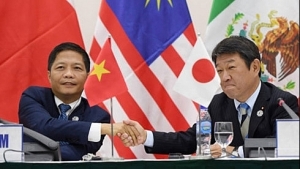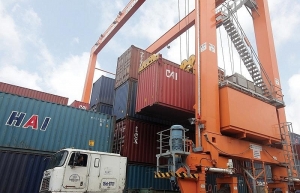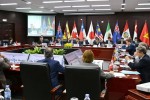Key differences between CPTPP and TPP
 |
| Vietnamese Minister of Industry and Trade Tran Tuan Anh and Japanese Minister of Economy Toshimitsu Motegi |
After the US withdrew from the Trans-Pacific Partnership (TPP) in 2017, the remaining 11 countries (Australia, Brunei, Canada, Chile, Japan, Malaysia, Mexico, New Zealand, Peru, Singapore, and Vietnam) agreed to maintain the deal and reshape it as the CPTPP.
The CPTPP basically keeps all the core content of the TPP and stands open for US to re-join. However, as many as 20 articles among the 8,000 pages of the CPTPP document have been postponed or revised.
First, the TPP has been renamed as the CPTPP, which includes “Comprehensive” and “Progressive.” This new name was highly appreciated by all country members, confirming the quality and normative direction of the new agreement.
“This is a comprehensive agreement, including various sectors, not only trade, investment or intellectual property. It is really higher and more progressive than the signature FTAs before,” said Japanese Economy Minister Toshimitsu Motegi.
Second, the number of member economies is 11. Together, they make up 13.5 per cent of the global GDP and 15.2 per cent of total global trade turnover, much lower than the TPP’s scale (due to a significant pull by the US) of 38.2 per cent of global GDP and 26.5 per cent of trade turnover.
Despite the withdrawal of the US, the CPTPP still covers huge markets like Japan, Australia, Canada, and Mexico, while the pressure to implement some articles has reduced significantly. Thereby, Vietnam will benefit from the agreement, which will strengthen linkages and collaboration in the region.
| This is a comprehensive agreement, including various sectors, not only trade, investment or intellectual property. It is really higher and more progressive than the signature FTAs before. |
Signing the CPTPP and movements from China have put pressure on the US to renegotiate membership. Meanwhile, China is currently playing the leading role in the Asia-Pacific economic integration process through the Regional Comprehensive Economic Partnership (RCEP), the ASEAN-China Free Trade Agreement, and the China-Japan-South Korea Free Trade Agreement.
Third, the effectiveness of the agreement has changed. According to the TPP, the agreement would take effect if the total GDP of the member countries captured 85 per cent of total GDP of the 12 signing countries in 2013. With the withdrawal of the US, which made up 60 per cent of the total GDP of the whole TPP, the eleven remaining countries had to change this. Therefore, if at least six nations approve the CPTPP, it may easily take effect 60 days after signing. Additionally, the new agreement also adds regulations related to the process of withdrawal, participation, and flexible reviewing of the CPTPP in the future.
Fourth, around 20 articles of the CPTPP have been temporarily postponed, including the strong commitments on intellectual property that the US raised before. Specifically, 11 of the 20 articles are on intellectual property. The CPTPP will delay requirements for member countries to change their laws and practices. The CPTPP also suspends the time term of a copyright in case of unreasonable delays in licensing. Members of the agreement will not have to extend protection terms from 50 to 70 years.
The remaining postponed articles are on investment. For the dispute solution mechanism between governments and investors (ISDS), the CPTPP has narrowed the mechanisms availability for foreign investors to sue the host member state. Besides, the CPTPP states that one member of the ISDS Arbitration Panel will be appointed by the government and the plaintiff each, and one by both.
As a result, through some adjustments of regulations and the efforts of the eleven member countries, the TPP has been “rescued.” The CPTPP is said to be a comprehensive and progressive agreement, reaching high standards while remaining open, which is expected to bring benefits to all country members.
 | CPTPP signing slated for March 8 in Chile The Comprehensive and Progressive Trans-Pacific Partnership (CPTPP) scheduled to be inked by ministers of the 11 member countries in Chile on March 8. |
 | Revived TPP will benefit its members without US While rumours circulate of the US potentially re-joining the Trans-Pacific Partnership, renamed the Comprehensive and Progressive Agreement for Trans-Pacific Partnership, the UK has also recently ... |
 | Breakthrough reforms needed to keep CPTPP benefits The Ministry of Planning and Investment (MPI) warned that benefits from the Comprehensive and Progressive Agreement for Trans-Pacific Partnership (CPTPP) could be reduced if Vietnam ... |
 | CPTPP to be signed in March The eleven members of the Comprehensive and Progressive Agreement for Trans-Pacific Partnership (CPTPP) have already completed the negotiations and expect to sign the agreement on ... |
What the stars mean:
★ Poor ★ ★ Promising ★★★ Good ★★★★ Very good ★★★★★ Exceptional
 Tag:
Tag:
Themes: CPTPP
Related Contents
Latest News
More News
- 72 nations sign landmark Hanoi cybercrime convention (October 26, 2025 | 18:00)
- UN Secretary-General commends Vietnam’s global leadership (October 26, 2025 | 09:00)
- APEC finance ministers convene to tackle regional challenges (October 22, 2025 | 17:31)
- Rewiring global trade: ASEAN’s rise as supply chain hub (October 17, 2025 | 11:40)
- Vietnam attends first World Nuclear Week Forum in Russia (September 26, 2025 | 10:50)
- Vietnam attends 69th session of IAEA General Conference (September 16, 2025 | 10:00)
- ADB, WB pledge over 12 billion USD for ASEAN power grid, renewable energy projects (August 15, 2025 | 14:18)
- Lowy Institute proposes AI-based tobacco control solutions for ASEAN (August 15, 2025 | 14:14)
- Cloud computing policy to position Malaysia as regional hub by 2030 (August 15, 2025 | 14:11)
- Thailand, Cambodia suffer numerous cyber attacks (August 05, 2025 | 16:19)























 Mobile Version
Mobile Version